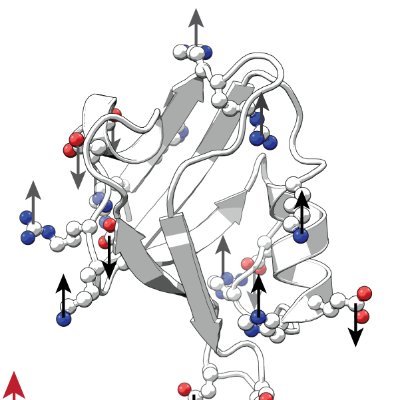
Hekstra Lab
@HekstraLab
Followers
496
Following
70
Media
18
Statuses
80
Research group of Prof. Doeke Hekstra | Harvard Department of Molecular & Cellular Biology
Cambridge, MA
Joined January 2021
Can AlphaFold refine structures for X-ray & Cryo-EM/ET data? Now it can! Great collab with @MoAlQuraishi and Randy Read, led by Alisia @FadiniAli and @mhli41. Preprint: https://t.co/Ol8EJ8N6ep Summary 🧵below. Code to follow...
biorxiv.org
Advances in machine learning have transformed structural biology, enabling swift and accurate prediction of protein structure from sequence. However, challenges persist in capturing sidechain...
Structural biology is in an era of dynamics & assemblies but turning raw experimental data into atomic models at scale remains challenging. @mhli41 and I present ROCKET🚀: an AlphaFold augmentation that integrates crystallographic and cryoEM/ET data with room for more! 1/14.
4
8
50
Led by Rick Hewitt and Kevin Dalton, the result is Laue-DIALS, hosted by @rs-station.bsky.social at https://t.co/vL9M95RkD4. Wanna try this out but need advice? Please get in touch. Further upgrades coming soon! Read more at https://t.co/H2deWH92zx 2/2
pubs.aip.org
Most x-ray sources are inherently polychromatic. Polychromatic (“pink”) x-rays provide an efficient way to conduct diffraction experiments as many more photons
0
0
2
X-ray diffraction can access protein dynamics. Why so few datasets? One reason? Lack of powerful pulsed X-ray sources. XFELs are limited. Synchrotrons throw away >99% of photons. Working with Aaron Bewster (DIALS/LBNL) and BioCARS ( https://t.co/YY3IL6fJ4x) to change this! 1/2
1
0
3
Enabling better crystal structures & better structure prediction. Can’t wait to see where folks take that! SFCalculator is implemented in PyTorch, TensorFlow, and JAX. Open Source. See https://t.co/cwl1zYOz6U for more info & https://t.co/k9a3BwL3qJ to get started. 4/4
github.com
Contribute to Hekstra-Lab/SFcalculator development by creating an account on GitHub.
0
3
49
With SFCalculator you can also *train* structure prediction / generative models directly on X-ray data. As @JHoltonMADSci has shown, the data are much more accurate than the models. 3/4
1
1
16
We can refine protein structures by searching the latent space of pre-trained generative models. Using a Boltzmann Generator (@FrankNoeBerlin) as an example, doing so yields models with good physics & data fit! 2/4
1
5
38
Crystal structures are *not* God-given truth. They approximate, w/ flaws & errors, X-ray diffraction data. AlphaFold etc. have been trained on structures, not data. SFCalculator now differentiably connects structures to diffraction data. What does this enable? 🧵 1/4
10
83
426
Fruit of a close collaboration with Rama Ranganathan's group, where Doeke, Ian (@kiwhite), and Rama first developed EFX, and BoRam worked tirelessly to grow crystals and analyze data. New hardware and software from @HekstraLab were critical for success! 8/8
0
0
2
In evolution, members of a protein family are often variations on a theme. The dynamic states resemble stable states of other channels: The sequence of steps of ion permeation is conserved from channel to channel with variations in relative energy. 7/8
1
0
0
Does the channel itself move? Yes! It moves as the ions pass, differently depending on the direction of ion flow. This suggests how rectification (asymmetric currents) can evolve. 6/8
1
0
1
What do we see? K+ ions coming in, hopping, and leaving. We see the K+ ions move, putting on a new “coat” of water molecules as they exit. 5/8
1
0
1
The experiment in simple: a crystal between two electrodes; X-rays coming in from the side: 4/8
1
0
0
Crystals of NaK2K, (H/T Youxing Jiang at @UTSouthwestern), form an ideal starting point: all ion channel pores are easily aligned with electric field (E): half of them “up”, half “down”. The red spheres are K+ ions: 3/8
1
0
0
Key is EF-X, a technique in which we apply electric field (EF) pulses to protein crystals and see the resulting motions with X-ray pulses. Physiological electric field, temperature, and timescales are all accessible. 2/8
1
0
1
Now in Cell: K+ ion channels enable electric currents consisting of potassium ions to generate action potentials in heart, brain, and muscle. For the first time, we can now see these currents atom-by-atom. https://t.co/PnpLhwMvGf a thread🧵 1/8
cell.com
Direct visualization of electric field-driven ion permeation in a potassium channel exposes a conserved mechanism underlying the reaction coordinate.
4
17
98
Thanks @MCB_Harvard for the news feature about our latest paper, out now in Cell!
Watching Ion Channels in Action @HekstraLab @RachelleGaudet @msm91283 @mklureza @UChicago @Stanford @HarvardCCB @Harvard @HarvardGSAS
https://t.co/FTHBJJmrsF
0
1
9
Excited to share my undergraduate work @biorxivpreprint w/ @HekstraLab and @mklureza: "Mapping protein conformational landscapes from crystallographic drug fragment screens." Check it out:
1
2
5





